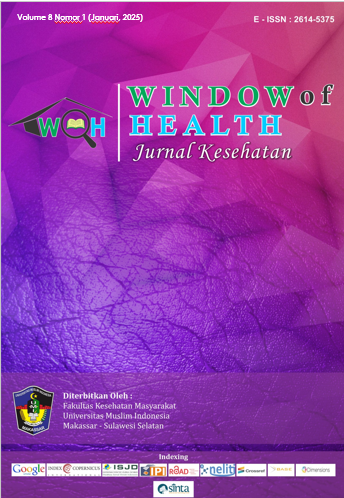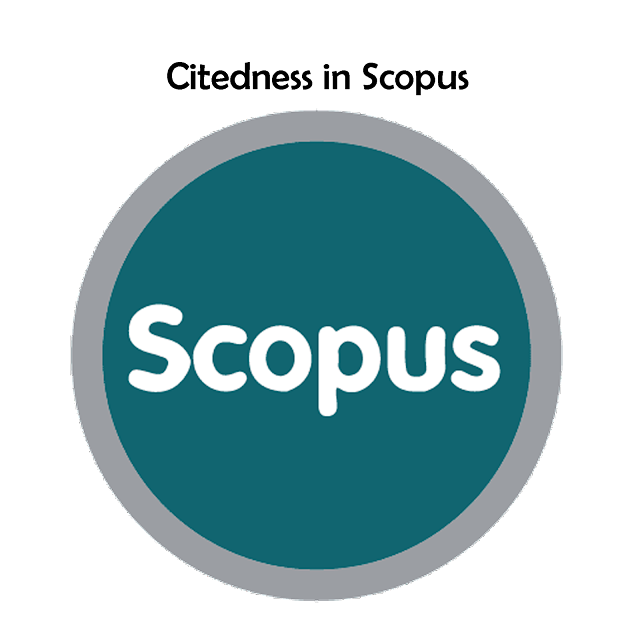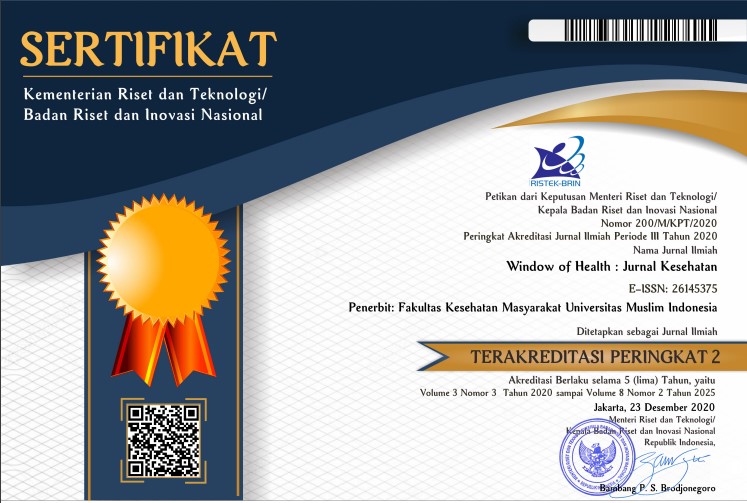Correlation of Ultra-processed Food Consumption with Nutritional Status and Blood Pressure in Adolescents
Abstract
Adolescents are nutritionally vulnerable, and their intake is crucial to avoid nutritional problems during growth. Adolescent food consumption can be obtained from various types of food, one of them ultra-processed food (UPF). This study aims to determine the relationship between ultra-processed food consumption patterns and nutritional status and blood pressure in Catholic Junior High School Sudiang adolescents and Christian Elim High School Makassar. Methods: This study is a quantitative descriptive study with a cross-sectional design. The sample was selected using a proportional random sampling technique of 195 adolescents aged 13-18. UPF consumption was collected using the Semi Quantitative Food Frequency Questionnaire (SQ-FFQ). The research results show adolescents are overweight at 25.6% and obese at 21%; elevated blood pressure (BP) is 14.4%, and state hypertension (HTN) is 8.2%. In addition, obese adolescents with state 1 HTN were 17.1% and elevated BP by 24.4%, while overweight adolescents with state 1 HTN were 8% and elevated BP by 14%. There is a correlation between the amount of UPF consumption and nutritional status (p-value = 0.047). At the same time, the results were negative between the frequency of UPF consumption and nutritional status (p-value = 0.312), the amount of UPF consumption and BP (p-value = 0.289), and the frequency of UPF consumption and BP (p-value = 0.059). The study concludes a significant correlation between the amount of ultra-processed food consumption and nutritional status in adolescents. Further research and public health interventions are recommended to address the impact of UPF on adolescent health.
References
World Health Organization. (2022). Adolescent health. World Health Organization. https://www.who.int/health-topics/adolescent-health#tab=tab_1
Muchtar, F., Sabrin, S., Effendy, D. S., Lestari, H., & Bahar, H. (2022). Pengukuran status gizi remaja putri sebagai upaya pencegahan masalah gizi di Desa Mekar Kecamatan Soropia Kabupaten Konawe. Abdi Masyarakat, 4(1), 43–48.
Peraturan Menteri Kesehatan Republik Indonesia Nomor 28 Tahun 2019 tentang Angka Kecukupan Gizi Yang Dianjurkan Untuk Masyarakat Indonesia, (2019).
Hafiza, D., Utmi, A., & Niriyah, S. (2020). Hubungan Kebiasaan Makan Dengan Status Gizi Pada Remaja Smp Ylpi Pekanbaru. Jurnal Medika Hutama, 2(01), 86–96.
Widnatusifah, E., Battung, S., Bahar, B., Jafar, N., & Amalia, M. (2020). Gambaran Asupan Zat Gizi Dan Status Gizi Remaja Pengungsian Petobo Kota Palu. Jurnal Gizi Masyarakat Indonesia: The Journal of Indonesian Community Nutrition, 9(1), 17–29.
Masdarwati, M., Kadir, E., Imran, A., & Handayani, E. T. (2022). Factors Associated with Obesity Incidence in the Military Command XIV/Hasanuddin Makassar. Al GIZZAI: PUBLIC HEALTH NUTRITION JOURNAL, 2(1), 23–32.
WHO. (2024). Obesity and overweight. https://www.who.int/news-room/fact- sheets/detail/obesity-and-overweight
Kemenkes RI. (2023). Survey Kesehatan Indonesia (SKI) Dalam Angka. Jakarta: Badan Kebijakan Pembangunan Kesehatan Kemenkes RI.
Kementerian Kesehatan RI. (2018). Laporan Hasil Riset Kesehatan Dasar (Riskesdas) 2018. Lembaga Penerbit Badan Penelitian dan Pengembangan Kesehatan (LPB).
Nurhidayati, N., Irawan, I. R., & Sudikno, S. (2022). Hubungan Obesitas Dengan Profil Lipid Pada Remaja Di Indonesia. Penelitian Gizi Dan Makanan (The Journal of Nutrition and Food Research), 45(1), 35–46.
Shaumi, N. R. F., & Achmad, E. K. (2019). Kajian Literatur: Faktor Risiko Hipertensi pada Remaja di Indonesia. Media Penelitian Dan Pengembangan Kesehatan, 29(2), 115– 122.
Sudikno, S., Mubasyiroh, R., Rachmalina, R., Arfines, P. P., & Puspita, T. (2023). Prevalence and associated factors for prehypertension and hypertension among Indonesian adolescents: a cross-sectional community survey. BMJ Open, 13(3), 1–13.
Saputri, Al-Bari Akhmad, &, & Kusuma, P. R. I. (2021). Hubungan Status Gizi Dan Aktivitas Fisik Dengan Kebugaran Jasmani Remaja. Jurnal Gizi, 10(2), 10–19.
Hidayatullah, M. T., & Pratama, A. A. (2019). Hubungan kebiasaan merokok dan obesitas dengan kejadian hipertensi pada remaja usia 15-19 tahun di Kelurahan Dayen Peken Ampenan Mataram. Prosiding Call For Paper Smiknas, 7(7), 108–115.
Faza, F., Bafani, U. F. F., & Fikha, I. I. (2023). Makanan ultra-proses berperan sebagai mediator hubungan ketahanan pangan dengan status kelebihan gizi atau obesitas pada dewasa: Literature review. Amerta Nutrition, 7(1), 161–174.
Calcaterra, V., Cena, H., Rossi, V., Santero, S., Bianchi, A., & Zuccotti, G. (2023). Ultra- Processed Food, Reward System and Childhood Obesity. Children, 10(804), 1–25.
Nardocci, M., Polsky, J. Y., & Moubarac, J. C. (2021). Consumption of ultra-processed foods is associated with obesity, diabetes and hypertension in Canadian adults. Canadian Journal of Public Health, 112(3), 421–429. https://doi.org/10.17269/s41997-020-00429-9
Pratiwi, F. I., Ulvie, Y. N. S., Handarsari, E., & Susantini, P. (2021). Konsumsi Mie Instan dan Status Gizi Remaja di Desa Kalongan Ungaran Timur Kabupaten Semarang. Prosiding Seminar Nasional UNIMUS, 4, 1400–1407.
Nutricheck. (2019). https://www.nutricheck.id/. Nutriteam
Monteles, N., Karoline Dos Santos, O., Gomes, K. R. O., Malvina Thais Pacheco, R., & Karoline de Macêdo Gonçalves, F. (2019). The impact of consumption of ultra-processed foods on the nutritional status of adolescents. Revista Chilena de Nutricion, 46(4), 429– 435.
Pratiwi, A. A., Chandra, D. N., & Khusun, H. (2022). Association of Ultra Processed Food Consumption and Body Mass Index for Age among Elementary Students in Surabaya. Amerta Nutrition, 6(2), 140–147.
Setyaningsih, A., Mulyasari, I., Afiatna, P., & Putri, H. R. (2024). The Relationship between Ultra-Processed Food Consumption with Diet Quality and Overweight Status in Young Adults. Amerta Nutrition, 8(1), 124–129.
Elizabeth, L., Machado, P., Zinöcker, M., Baker, P., & Lawrence, M. (2020). Ultra- processed foods and health outcomes: A narrative review. Nutrients, 12(7), 1–36.
Ginting, S. M. D., Februhartanty, J., & Khusun, H. (2024). Association between consumption of ultra-processed foods and beverages with nutritional status of private senior high school students in Pontianak, West Kalimantan, Indonesia. World Nutrition Journal, 7(i2), 90–103.
Magalhães, V., Severo, M., Correia, D., Torres, D., Costa De Miranda, R., Rauber, F., Levy, R., Rodrigues, S., & Lopes, C. (2021). Associated factors to the consumption of ultra-processed foods and its relation with dietary sources in Portugal. Journal of Nutritional Science, 10, 1–11.
Nardocci, M., Leclerc, B. S., Louzada, M. L., Monteiro, C. A., Batal, M., & Moubarac, J.C. (2019). Consumption of ultra-processed foods and obesity in Canada. Canadian Journal of Public Health, 110(1), 4–14.
Hartati, Y., Wijaya, K., & Telisa, I. (2023). Gambaran Besar Porsi, Asupan Zat Gizi terhadap Status Gizi Mahasiswa di Asrama. Jurnal Pusat Akses Kajian Pangan Dan Gizi, 2(3), 57–64.
Costa, B., Sofia, I., Melo, V. De, Criso, C. A., Flor, T., & Bueno, N. B. (2017). Consumption of minimally processed food is inversely associated with excess weight in adolescents living in an underdeveloped city. Plos One, 12(11), 1–10.
Hess, J. M., Comeau, M. E., Casperson, S., Slavin, J. L., Johnson, G. H., Messina, M., Raatz, S., Scheett, A. J., Bodensteiner, A., & Palmer, D. G. (2023). Dietary Guidelines Meet NOVA: Developing a Menu for A Healthy Dietary Pattern Using Ultra-Processed Foods. Journal of Nutrition, 153(8), 2472–2481.
Kemenkes. 2024. https://sehatnegeriku.kemkes.go.id/baca/rilis- media/20240131/2544885/cegah-meningkatnya-diabetes-jangan-berlebihan-konsumsi- gula-garam-lemak/
Listiana Putri, A., Arini, F. A., Amar, M. I., & Fatmawati, I. (2023). Hubungan Asupan Natrium, Asupan Lemak, Status Gizi (IMT/U), dan Aktivitas Fisik dengan Tekanan Darah Pada Remaja Correlation between Sodium Intake, Fat Intake, Nutritional Status (BMI/U), and Physical Activity with Blood Pressure in Adolescents. Medika Respati : Jurnal Ilmiah Kesehatan, 18(1), 1–10.
Octarini, D. L., Meikawati, W., & Purwanti, I. A. (2023). Hubungan Kebiasaan Konsumsi Makanan Tinggi Natrium dan Kalium Dengan Tekanan Darah Pada Usia Lanjut. Prosiding Seminar Kesehatan Masyarakat, 1, 10–17.
Da Conceição, A. R., De Almeida Fonseca, P. C., De Castro Morais, D., & De Souza, E.C. G. (2018). Association of the degree of food processing with the consumption of nutrients and blood pressure. Mundo Da Saude, 43(2), 512–529.
Rezende-Alves, K., Hermsdorff, H. H. M., Miranda, A. E. D. S., Lopes, A. C. S., Bressan, J., & Pimenta, A. M. (2020). Food processing and risk of hypertension: Cohort of Universities of Minas Gerais, Brazil (CUME Project). Public Health Nutrition, 24(13), 4071–4079.
Syafni, Alfauzia, and Hartanti Sandi Wijayanti. 2015. “Hubungan Konsumsi Western Fast food dengan Hipertensi Pada Remaja Di Sma N 1 Semarang.” Journal of Nutrition College 4(2): 358-364.
Mardianti, F., Rachmawati, D., & Suprajitno. (2020). Risk factors for hypertension in adolescents. Jurnal Kesehatan Hesti Wira Sakti, 10(01), 43–55.
Copyright (c) 2025 Anna Khuzaimah

This work is licensed under a Creative Commons Attribution-NonCommercial-ShareAlike 4.0 International License.








